At Cape Hatteras National Seashore (CAHA) field technicians began monitoring for piping plovers (PIPL) in early March of 2014. The first nests of the 2014 breeding season were discovered on April 22nd while the last nest was lost to overwash produced by Hurricane Arthur on July 4th. Twelve breeding pairs and fourteen nests were identified during the 2014 breeding season. Five chicks successfully fledged resulting in a fledge rate of 0.42 chicks per breeding pair.
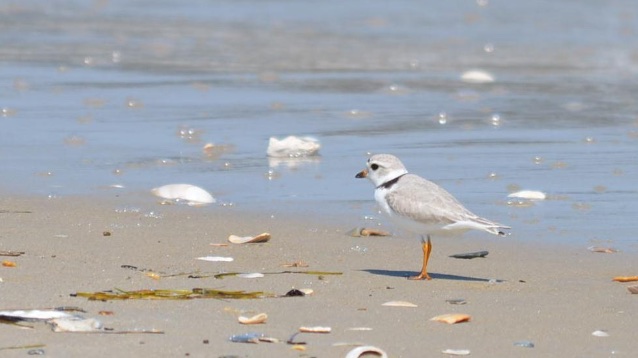
Introduction
Routine monitoring of PIPL at CAHA began in 1985. The Atlantic population was listed as threatened under the Endangered Species Act in 1986. Monitoring focused on locating and protecting breeding territories to aid in determining nest and brood success. This report contains a summary of monitoring results for the 2014 breeding season, comparisons of results from previous years, and the resource management activities undertaken for PIPL in 2014.
On February 15, 2012 the Cape Hatteras National Seashore Off-Road Vehicle Management Plan and Special Regulation (2012, ORVMP) was enacted. It was developed from 2007-2012 and was accompanied by a special regulation detailing requirements for off-road vehicle (ORV) use at CAHA. A copy of the ORV Management Plan and other related documents are available electronically at: https://parkplanning.nps.gov/caha. The ORV Management Plan includes establishment of pre-nesting closures and buffer requirements for nesting birds and chicks as well as the requirement for an ORV permit to drive on CAHA beaches.
The 2014 breeding season was the third season managed under the requirements of the ORVMP.
The Record of Decision indicates that CAHA will "conduct a systematic review of data, annual reports, and other information every 5 years, after a major hurricane, or if necessitated by a significant change in protected species status (e.g. listing or de-listing), in order to evaluate the effectiveness of management actions in making progress toward the accomplishment of stated objectives". As part of the Reporting Requirements of the Biological Opinion (BO) for the Off- road Vehicle Management Plan (November 15, 2010), "an annual report detailing the monitoring and survey data collected during the preceding breeding season (as described in alternative F, in addition to the additional information required in the... Terms and Conditions) and summarizing all piping plover, seabeach amaranth, and sea turtle data must be provided to the Raleigh Field Office by January 31 of each year for review and comment".
Methods
Closures
A required yearly habitat assessment was conducted from February 3 - February 20, prior to the onset of the breeding season. This assessment, along with historic nesting locations, was used to determine the boundaries for pre-nesting closures (Appendix A, Maps 1-4). These sites were then posted with symbolic fencing consisting of wooden posts, bird usage signs prohibiting entry, string, and flagging tape by March 15, as required by the ORV Management Plan. While pre-nesting closures minimize disturbance in potential breeding areas, they also enable birds to establish territories and nest in their preferred habitat. Bodie Spit, Cape Point, South Beach, North Ocracoke, and South Point all contained potential and/or historic nesting habitat for PIPL.
The pre-nesting closures were modified throughout the season in order to meet the buffer requirements of the ORV Management Plan and to provide adequate protection for nesting birds and broods. Buffers for PIPL include a 75 m buffer for breeding behaviors and for nests. When unfledged chicks are present, this buffer is either expanded to 1000 m in ORV areas or 300 m in pedestrian areas. A closure was modified when breeding behavior (territorial behavior, courtship, or mating) was observed close to the edge or outside of a closure or if a scrape, nest or chick was located with inadequate buffers.
Monitoring
Seasonal monitoring for PIPL began in early March. Predator exclosures were constructed around nests when they were located and found to contain three or more eggs. Exclosures have been used at CAHA since 1994 to reduce predatory pressure on PIPL nests and nesting adults. Circular exclosures (roughly ten feet in diameter), were made of two inch by four inch welded- wire fence, anchored by steel rebar, and topped with a three-quarter inch mesh netting to dissuade predators. Exclosures were installed following the guidelines established in the USFWS’ Piping Plover Recovery Plan (USFWS 1996, Appendix F). Thereafter, the nest was briefly approached once a week to inspect the exclosure, verify the number of eggs and check for signs of predators.
The nests were monitored daily, from a distance, to document incubation, nest abandonment and abnormal behavior. Morning and evening monitoring began five to seven days prior to the expected hatch date. Broods were then monitored regularly in the morning and in the afternoon until the chicks fledged or were determined to be lost. Observers documented: brood status, behavior, habitat use, individual bird, brood movements, human disturbance, predator interactions, and significant environmental events. A grid system with points located 75 meters apart was established at historical breeding territories at the beginning of the breeding season to aid staff in obtaining more accurate locations for individuals, nests and chick movement.
Predator Control
In 2014, predator control was implemented to target mammalian predators. Trapping was conducted in response to reported signs of predators in close proximity to nests, chicks or closures. Trapping efforts were increased in areas of recurring predatory signs when resources were available. Traps were installed with the intent of targeting the specific predators reported in those areas.
Winter Closures
Winter closures are established to provide a relatively undisturbed area for migratory and wintering PIPL. In the fall, and to a lesser degree in the spring, large numbers of PIPL migrate through CAHA. Winter closures were established upon removal of the pre-nesting closures at Bodie Spit and South Point.
The winter closures are closed to ORV use, however, portions of them remain open to pedestrians. Permanent Vehicle Free Areas (VFA), especially those at Cape Point, South Beach and North Ocracoke, provide relatively undisturbed areas for migratory and wintering PIPL in addition the winter closures at Bodie Spit and South Point.
Migrating and Wintering Piping Plovers
Survey protocols adapted from the Southeast Coast Inventory Monitoring Network’s Migratory and Wintering Shorebird Monitoring Study (Byrne et al, 2009) were implemented weekly from April 2013 through March 2014. Surveys were not conducted in June when all the PIPL present were assumed to be breeders and not migrants. Transect sampling consisted of a two-tiered approach comprised of high-intensity and low-intensity sampling units. The high-intensity sites were sampled on a weekly basis whereas the low-intensity sampling units were sampled on a monthly basis. Semi-permanent transect locations were established along the entire ocean shoreline. The majority of transects were one mile in length and were numbered Park Mile 0 through Park Mile 74. Some transects at the spits and Cape Point, varied in length due to the constantly changing shorelines. The spits and Cape Point also required more than one transect due to a larger topographical area (Appendix A, Map 6). All target species including PIPL, American oystercatchers, Wilson’s plovers, red knots, black-necked stilts, whimbrels, and sanderlings were documented. The goal of the surveys is to determine areas of consistent use by the target species and to consistently and systematically collect data that park managers can utilize when making management decisions.
Results and Discussion
Nest and Brood Success
In 2014, nesting was identified at three sites: Cape Point on Hatteras Island, North Ocracoke and South Point on Ocracoke Island (Appendix A, Maps 2, 3 and 4 respectively). Nesting has not been documented on Bodie Island since 2012 (Appendix A, Map 1). The first nest of the 2014 breeding season was discovered on April 22nd and the last nest was lost to overwash produced by Hurricane Arthur on July 4th.
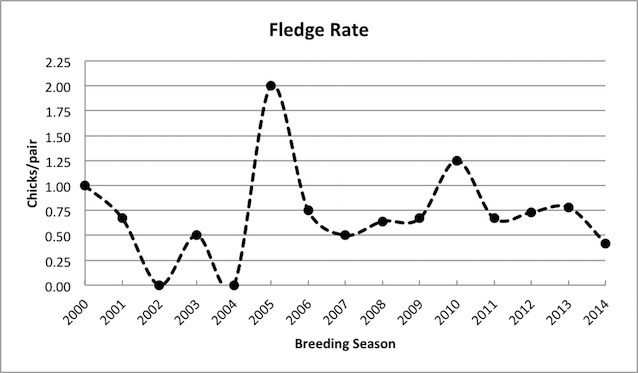
Figure 1. Piping plover historic fledge rate (chicks per pair) at CAHA.
Field technicians identified twelve breeding pairs which produced fourteen known nests. Seven nests successfully hatched at least one chick. A total of 41 eggs were documented, of which 21 hatched for a hatch rate of 51%. The average incubation period was 27 days and ranged from 24 to 29 days. Incubation period begins when the last egg of the clutch is observed or on the second day after the penultimate egg is initially observed and ends when the first chick is observed completely free of its shell.
Seven nests (50%) were lost prior to hatching and sixteen chicks (76%) were lost prior to fledging (Table 1). Two of seven broods produced fledglings and a total of five chicks fledged. Of the two broods that produced fledglings, the age at fledging ranged from 27 to 29 days. Five chicks fledged from 12 breeding pairs yielding a fledge rate of 0.42 chicks fledged per breeding pair (Figure 1).
Table 1. Piping plover Nest and Chick Success at CAHA in 2014.
| Location | Breeding Pairs |
Total Nests |
Nests Hatched |
Nests Lost/ Abandoned |
Total Eggs |
Total Eggs Hatches |
Total Chicks Fledged |
Total Chicks Lost |
| Bodie Island Spit | 0 | NA | NA | NA | NA | NA | NA | NA |
| Cape Point | 7 | 8 | 5 | 3 | 28 | 16 | 5 | 11 |
| South Beach | 0 | NA | NA | NA | NA | NA | NA | NA |
| North Ocracoke | 1 | 2 | 1 | 1 | 4 | 2 | 0 | 2 |
| South Point | 4 | 4 | 1 | 3 | 9 | 3 | 0 | 3 |
| TOTAL | 12 | 14 | 7 | 7 | 41 | 21 | 5 | 16 |
Since 2000, fledge rates have ranged from 0.0 to 2.0 chicks per pair at CAHA. The mean rate from 2000-2013 was 0.73 chicks per pair. The fledge rate for 2014 was 0.42 which is the lowest fledge rate since 2004.
Chick loss, as in previous years, was difficult to document. The majority of chick mortality occurred within four days post hatching (loss ranges are 1 to 20 days). Cape Point had a 57% hatch rate with 12 eggs lost (4 abandoned, 4 to overwash produced by Hurricane Arthur, 3 to ghost crabs, 1 to unknown cause) and all 11 of the chicks lost to unknown cause. North Ocracoke had a 50% hatch rate with 2 eggs lost (1 to unknown cause, 1 undocumented loss) and 2 chicks lost (1 to Hurricane Arthur, 1 to unknown cause). South Point had a 33% hatch rate with 9 eggs lost (3 to overwash caused by Hurricane Arthur, 2 to unknown cause, 1 undocumented loss). This is the second consecutive year that no nesting was observed on Bodie Spit.
Predator Exclosures
As in previous years, predator exclosures were used to protect the nests. After predator exclosures were installed, the nest was observed until one of the adult PIPL returned to the nest and resumed incubation. The average elapsed time before a bird accepted the exclosure was 15 minutes and ranged from 8 to 27 minutes. When a three-egg clutch is reached, adult PIPL will generally accept the exclosure sooner as continuous incubation usually occurs. Longer times can be expected for sporadic incubation characteristic of one or two-egg clutches.
Predatory pressure within CAHA may vary due to the geographic location of each island. Bodie Spit is attached to the mainland which provides a wildlife corridor for larger mammalian predators (i.e. canids). Hatteras Island is connected to Bodie Spit by the Herbert C. Bonner Bridge, which allows for the expansion of larger predators and Ocracoke Island is the only CAHA location isolated from the expansion of larger mammalian predators.
Chick Movement
During daily observations, field technicians documented foraging locations for all PIPL chicks (Appendix A, Map 5). Since chicks were not observed continuously from dawn to dusk or during the night, actual territories may be larger than depicted. A grid system with points located 75 meters apart was established at historical breeding territories at the beginning of the breeding season to aid staff in obtaining accurate locations for chicks. When chicks were observed, their locations were recorded relative to the grid points. The individual brood foraging areas designate the area in which the brood was observed on any given day until they fledged or were determined to be lost. The daily distance travelled by chicks from the two nests that yielded fledglings on Cape Point ranged from 278 m to 461 m. The estimated size of the foraging areas for the two nests ranged from 3.34 to 4.97 hectares. When chicks were lost soon after hatching, no foraging territory outside the immediate vicinity of the nest could be established.
Human Disturbance
Human disturbance, direct or indirect, can lead to the abandonment of nests and optimal breeding habitat, or loss of chicks. Throughout the 2014 breeding season, field staff documented 254 violations to closures with nesting shorebirds. Of these violations, 108 were documented in closures containing nesting PIPL or habitat protected for PIPL. These violations consisted of: 90 pedestrian, 4 ORV, 13 dog and 1 boat intrusions into closures. The numbers are conservative since sites are not monitored continuously, tracks are easily altered by weather and staff would not disturb an incubating adult or broods in order to document disturbance. It is important to note that most of the closures contained multiple species, including least terns, American oystercatchers, and PIPL. Most illegal entries were not witnessed, but documented based on vehicle, pedestrian, or tracks left in the sand. Since violations were primarily based on tracks, it is difficult to determine what the actual impact is on nesting shorebirds or chicks.
Non-breeding Surveys & Winter Monitoring
The non-breeding PIPL monitoring protocol was developed to document trends over time and to document the habitat type in which PIPL and other shorebirds are most frequently found. Documenting the habitat type in which the PIPL are observed will assist CAHA staff in determining which areas require future protection and helps minimize disturbance to migratory and wintering PIPL.
Field technicians surveyed 20-21 transects on a weekly basis for non-breeding PIPL use at CAHA. The time period covered in this report is April 2013 through March 2014 during which 137 PIPL observations were noted. Many observations occur outside of closures; transects are not surveyed if they fall within a pre-nesting or breeding closure. The closures likely contain migrants and breeding birds but in order to minimize disturbance to breeding birds, transects are not surveyed if pre-nesting or breeding closures are in place. During the breeding season, the emphasis is on minimizing disturbance to breeding birds. The peak seasonal migrations occurred in July 2013 (35 total: 34 Bodie Island, 1 South Hatteras) and March 2014 (33 total: 22 Bodie Island, 11 South Hatteras) when the majority of the migrants observed were documented on Bodie.)
Field technicians documented the habitat type in which migratory and wintering PIPL were observed from April 2013 to March 2014. Of the 137 observations, 47 were in foreshore habitat, 74 were in mud flat/algal flat habitat, 4 were in the backshore, 6 were in the wrack line and 6 were in "other" habitat.
References
Byrne, M. W., J. C. DeVivo, J. M. Maxfield, C. J. Wright, and E. Thompson. 2009. Methods for monitoring migratory and wintering shorebirds in Southeast Coast Network Parks. Natural Resource Report NPS/SECN/NRR-2009/107. National Park Service, Fort Collins, Colorado.
National Park Service. 2010. Cape Hatteras National Seashore Off-Road Vehicle Management Plan and Environmental Impact Statement. U. S. Department of the Interior, National Park Service, Cape Hatteras National Seashore, North Carolina.
U. S. Fish and Wildlife Service. 1996. Piping Plover (Charadrius melodus), Atlantic Coast Population, Revised Recovery Plan. USFWS Regional Office, Hadley, Massachusetts. Appendix F.
U. S. Fish and Wildlife Service. 2010. Biological opinion the Off-Road Vehicle Management Plan for Cape Hatteras National Seashore, Dare and Hyde Counties, North Carolina. U. S. Fish and Wildlife Service, Raleigh Field Office, Raleigh, NC. 156 pp.
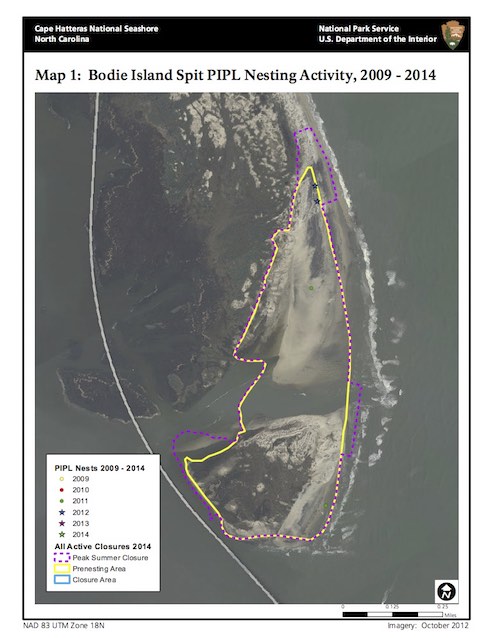
Appendix A: Maps
Map 1: Bodie Island Spit PIPL Nesting Activity, 2009–2014
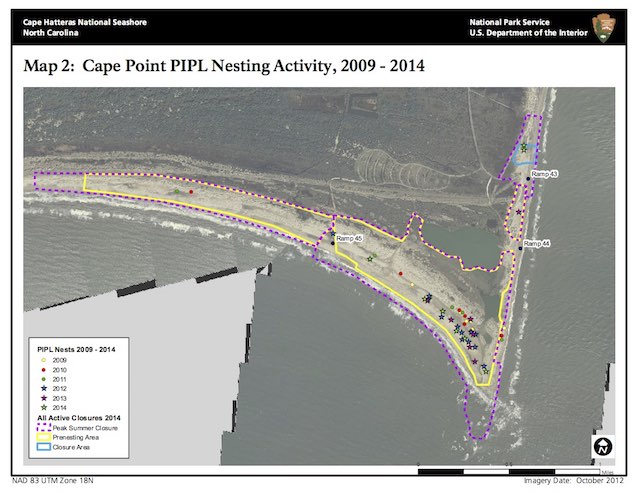
Map 2: Cape Point PIPL Nesting Activity, 2009–2014
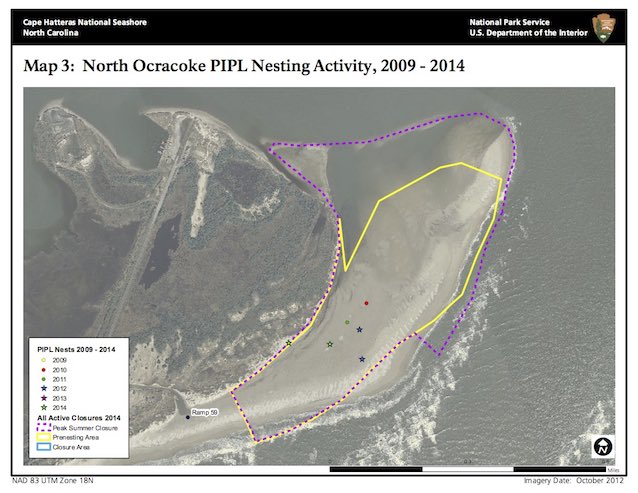
Map 3: North Ocracoke PIPL Nesting Activity, 2009–2014
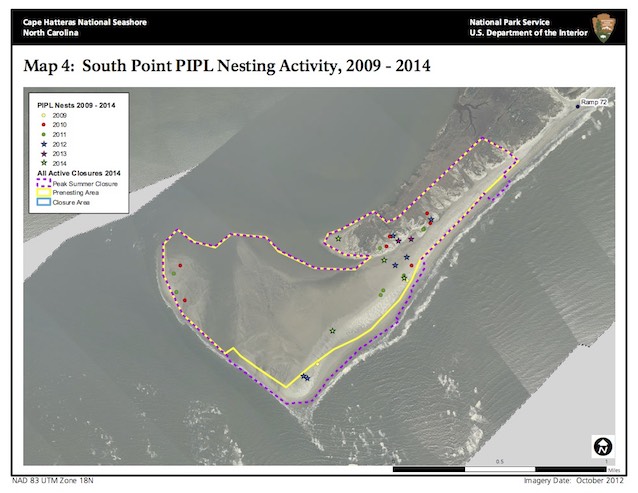
Map 4: South Point PIPL Nesting Activity, 2009–2014
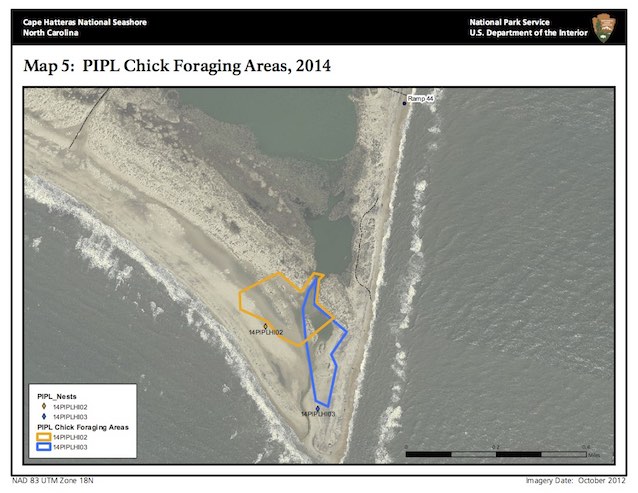
Map 5: PIPL Chick Foraging Areas, 2014
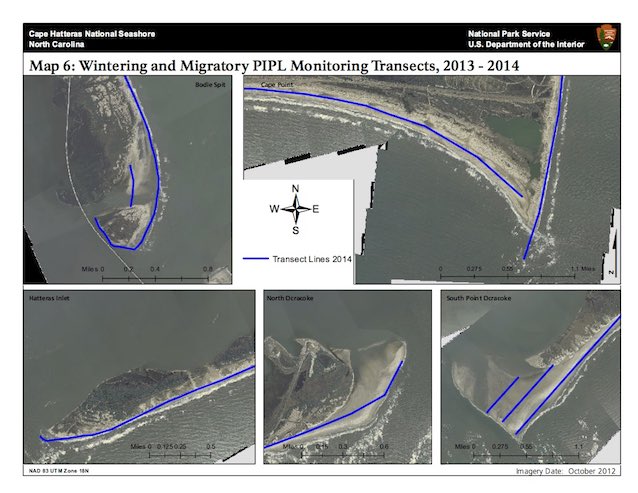
Map 6: Wintering and Migratory PIPL Monitoring Transects, 2013–2014
Last updated: December 19, 2017
